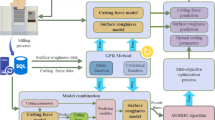Abstract
Generally, off-line methods are used for surface roughness prediction of titanium alloy milling. However, studies show that these methods have poor prediction accuracy. In order to resolve this shortcoming, a prediction method based on Cloudera’s Distribution including Apache Hadoop (CDH) platform is proposed in the present study. In this regard, data analysis and process platform are designed based on the CDH, which can upload, calculate, and store data in real time. Then this platform is combined with the Harris hawk optimization (HHO) algorithm and pattern search strategy, and an improved Harris hawk optimization optimization (IHHO) method is proposed accordingly. Then this method is applied to optimize the support vector machine (SVM) algorithm and predict the surface roughness in the CDH platform. The obtained results show that the prediction accuracy of IHHO method reaches 95%, which is higher than the conventional methods of SVM, BAT-SVM, gray wolf optimizer (GWO-SVM), and whale optimization algorithm (WOA-SVM).








Similar content being viewed by others
Availability of data and material
The data sets used or analyzed during the current study are available from the corresponding author on reasonable request.
Code availability
Not applicable.
References
Wang XM, Han J (2019) Study on surface roughness of TC4 titanium alloy in high speed milling. Mechanical design and manufacturing 5:232–236
Gong XY, Li BH, Chai XD, Gu M (2014) Overview of big data platform technology. J Syst Simul 26(03):489–496
Zhang T, Ling P (2014) Design, development and application of smart transportation big data platform. Proceedings of the 9th China Intelligent Transportation annual conference
Ramesh B (2015) Big data architecture. Big Data, Springer India
Zhong Y, Huang XD, Liu D, Huang YX, Tian W, Wang JM (2013) NoSQL storage scheme for large scale equipment monitoring data. Computer integrated manufacturing system 19(12):3008–3016
Xu H, Yang YF, Zhang L (2013) Extension of LaUD-KV aggregation operation supporting large-scale monitoring data analysis. Computer integrated manufacturing system 19(012):3035–3042
Dou M, Wen LJ, Wang JM, Yan ZX (2013) Parallel conversion algorithm of massive event logs based on MapReduce. Computer integrated manufacturing system 19(08):1784–1793
Wu H, Ni ZW, Wang HY (2012) Ant colony algorithm based on MapReduce. Computer integrated manufacturing system 07:1503–1509
Weng LH (2020) Application of big data technology in mechanical automation. Information recording materials 21(10):162–163
Chen XN (2021) Development trend of mechanical automation under the background of big data. Technological innovation and productivity 1:73–75, 78
Xian G (2020) Parallel machine learning algorithm using fine-grained-mode spark on a Mesos Big Data Cloud Computing Software Framework for Mobile Robotic Intelligent Fault Recognition. IEEE Access 99:1–1
Dong JL (2020) Research on evaluation method of milling cutter wear state based on CSSAE. Dissertation, Dalian University of Technology
Min T (2019) Research on online tool wear warning technology driven by big data. Dissertation, Nanjing University of Aeronautics and Astronautics
Jiang XN (2018) Research on carbon footprint accounting in parts processing based on Hadoop. Dissertation, Zhejiang Sci-Tech University
Sun QZ (2021) Optimization of titanium alloy milling parameters based on data mining technology. Dissertation, Harbin University of Science and Technology
Duan XY, Zhao YY, Chen YX, Ma C, Liao MF (2020) Mechanical life prediction and evaluation of high voltage circuit breaker based on spark. High voltage apparatus 56(09):80–86
Eser A, Ayyldz EA, Ayyldz M, Kara F (2021) Artificial intelligence-based surface roughness estimation modelling for milling of AA6061 alloy. Adv Mater Sci Eng 6:1–10
Xu LH, Huang CZ, Niu JH, Li CW, Wang J, Liu HL, Wang XD (2021) An improved case-based reasoning method and its application to predict machining performance. Soft Comput 25:5683–5697
Nan X, Zhou JF, Zheng BR (2018) An energy-based modeling and prediction approach for surface roughness in turning. Int J Adv Manuf Syst 96:5–8
Heidari AA, Mirjalili S, Faris H, Aljarah I, Mafarja M, Chen HL (2019) Harris hawks optimization: algorithm and applications. Futur Gener Comput Syst 97:849–872
Fu W, Shao K, Tan J, Wang K (2020) Fault diagnosis for rolling bearings based on composite multiscale fine-sorted dispersion entropy and SVM with hybrid mutation SCA-HHO algorithm optimization. IEEE Access 99:1–1
Usman BT, Ali Z, Yang F, Lu J, Muhammad K (2020) Short-term load forecasting for microgrid energy management system using hybrid HHO-FNN model with best-basis stationary wavelet packet transform. Energy 203
Zhang MX, Zhang DM, He RL (2018) Chicken colony optimization algorithm based on pattern search method. Microelectronics and computer 35(04):46–52
Gong C, Wang ZL (2012) Proficient in MATLAB optimization calculation. Electronic Industry Press, Beijing
Zhu, QH (2018) Research and application of support vector machine based on improved ant colony algorithm. Dissertation, Anhui University of Science and Technology
Funding
This research is supported by National key R&D plan and network collaborative manufacturing and smart factory special project: “Complex Tool Monitoring and Full Life Cycle Intelligent Management and Control Technology” under grant no. 2019YFB1704800, International (regional) cooperation and exchange program of national Natural Science Foundation of China under grant no. 51720105009, and Outstanding Youth Fund of Heilongjiang Province (grant number YQ2019E029).
Author information
Authors and Affiliations
Contributions
XL, CY, QS, and XW contributed to the conception of this research. YS designed and built CDH platform and optimized the prediction algorithm. YQ participated in the debugging of the algorithm program; SYL and LW gave many constructive suggestions on the revision of the thesis.
Corresponding author
Ethics declarations
Ethics approval
The content studied in this article belongs to the field of metal processing and does not involve humans and animals. This article strictly follows the accepted principles of ethical and professional conduct.
Consent to participate
The authors would like to opt in to In Review.
Consent for publication
The authors agree with the Copyright Transfer Statement.
Conflict of interest
The authors declare no competing interests.
Additional information
Publisher's Note
Springer Nature remains neutral with regard to jurisdictional claims in published maps and institutional affiliations.
Rights and permissions
About this article
Cite this article
Liu, X., Sun, Y., Yue, C. et al. Surface roughness prediction method of titanium alloy milling based on CDH platform. Int J Adv Manuf Technol 119, 7145–7157 (2022). https://doi.org/10.1007/s00170-021-08554-6
Received:
Accepted:
Published:
Issue Date:
DOI: https://doi.org/10.1007/s00170-021-08554-6




